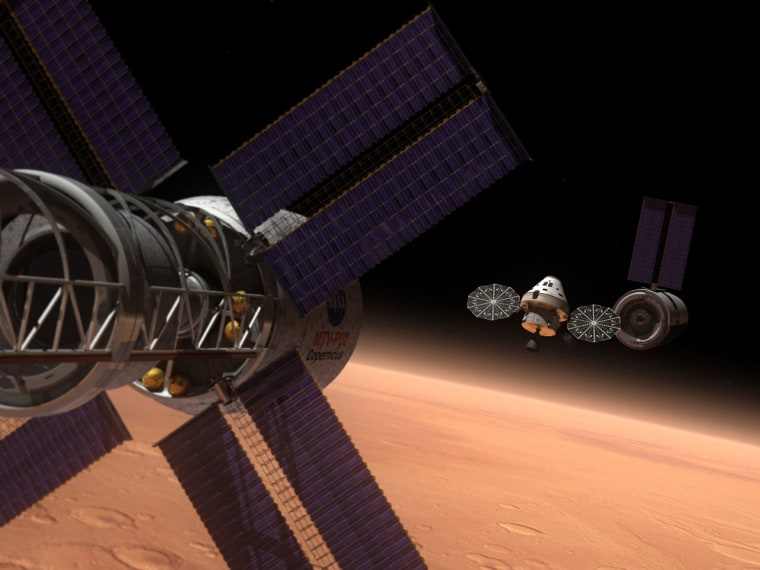Mars has teased the imagination since early astronomers discovered that it doesn’t flicker. It glows red as it moves forward and backward in odd, yet predictable, patterns. It was noted in the records of Babylonian, Chinese and Mayan stargazers, and it has figured prominently in ancient mythology.
Galileo developed the science of astronomy with his invention of the telescope, and as knowledge of our planetary neighbor grew, Mars appeared to bear a strange kinship to Earth. Astronomers determined that it had close to a 24-hour day and the appearance of an atmosphere, and some even speculated that it harbored intelligent life.
As telescopes improved, observers learned that Mars had two moons, a polar cap and a curious array of surface features — the notorious canali, described by Italy's Giovanni Schiaparelli in 1877.
We Earthlings have sent robots to study Mars' surface many times over the past three decades. Last month, NASA announced new findings: If life ever existed on Mars, the longest-lasting habitats were most likely below the Red Planet’s surface.
The new interpretation comes from years of mineral-mapping data, covering more than 350 sites on Mars examined by European and NASA spacecraft. The study suggests that Martian environments with abundant liquid water existed only during short episodes. These episodes occurred toward the end of hundreds of millions of years during which warm water interacted with subsurface rocks. If the research holds up, it's plausible to think that life in some form could have existed back then.
“Our interpretation is a shift from thinking that the warm, wet environment was mostly at the surface to thinking it was mostly in the subsurface, with limited exceptions,” said Johns Hopkins University's Scott Murchie, principal investigator for the CRISM spectrometer on NASA's Mars Reconnaissance Orbiter.
Murchie said that one of the exceptions might be Gale Crater, the landing site for NASA’s $2.5 billion Mars Science Laboratory mission. A car-sized rover named Curiosity is on its way to land in August near the foot of a layered mountain inside the crater. Layers of this mountain contain water-formed minerals, and the rover will travel for miles investigating the alluvial fan of water-carried sediments. NASA hopes the mission will help experts figure out how future humans could live on the Martian landscape.
The question is, can NASA afford to think about sending humans to Mars when the space agency is at what are arguably the most perplexing crossroads in its 53 years of existence?
NASA is busy turning over many of its routine operations in low Earth orbit to commercial partners, while setting its sights on what America’s greatest exploration arm should be doing.

Here's how NASA's deputy administrator, Lori Garver, described the situation this month: "Our commercial partners are making real progress opening up a new job-creating segment of the economy that will allow NASA to focus on our next big challenges — missions to asteroids and Mars."
Think about it: We have to build multiple homes in our solar system at some point, or else there will have to come a time when we simply take our place among the extinct.
For the moment, we inhabit a stirring, surging, moving, living planet. Earth is simply the spaceship where we see the beginning of life, its present ... and its end. Our spaceship’s bounty is finite. Its supply of energy, foodstuffs, clean atmosphere and pristine water will sooner or later be depleted.
As NASA enters 2012 with our astronauts’ launch pads dormant, we have a choice. We can just go with the flow, and slouch down the road that the dinosaurs took. Or NASA can stop its incessant drifting, and move forward with its partners to build the heavy-lift and deep-flight spaceships that will eventually make Mars the second-safest place for humans in the solar system.
'One Cannot Live in the Cradle Forever': An excerpt from 'Moon Shot'
One should read the words written more than a century ago by Russian scientist and schoolteacher Konstantin E. Tsiolkovsky. He was the first person to envision the use of rockets for space travel. In a simple but wonderful turn of words, Tsiolkovsky surveyed the future and saw what the human race must do and where it must go."Earth is the cradle of the mind," wrote the self-taught man who reached for tomorrow, "but one cannot live in the cradle forever."If Tsiolkovsky is correct, and he surely must be, then let it be written that Alan Shepard and Neil Armstrong and their fellow moonwalkers took the first faltering steps from the cradle, knowing their planet one day would pass into history.If humans were successful in journeying to Mars and populating other planets, then the human race would not be without a future. A star might go nova and obliterate an entire solar system, disease, drought, and parched lands might sweep Earth, but if humans populate other solar systems ... then life will go on.
The great storyteller Ray Bradbury, who spun tales about attempts to colonize Mars in "The Martian Chronicles," wrote: "We are all ... children of this universe. Not just Earth, or Mars, or this system, but the whole grand fireworks."
We invite you to join us in the new year for "Getting to Mars," a new series of reports about the future of Red Planet missions and the prospects for making Mars our second planetary home. It just might be the 21st century's promised land.
More from 'Moon Shot':
NBC News' Jay Barbree is the only journalist to cover every spaceflight flown by astronauts from Cape Canaveral. He has won NASA’s highest medal for public service and the National Space Club’s 2009 Press Award. Barbree also has written several books about the space effort, including an updated version of published by Open Road Integrated Media and available from , , , and . "Moon Shot" excerpt updated and reprinted with permission, copyright 2011.
